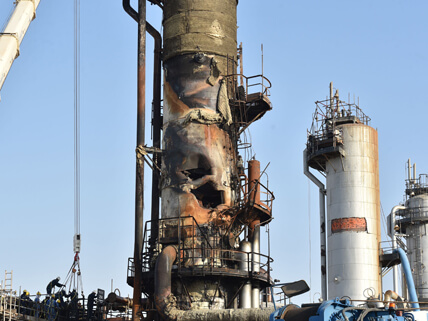Oil-processing plant in Abqaiq, in eastern Saudi Arabia, damaged by drone strike on September 15, 2019
A series of drone and missile strikes on Saudi Arabia’s oil-processing facilities on September 15 has rattled global oil markets. Saudi Arabia, the largest global oil exporter, supplies about 10 percent of the world’s oil. The attacks hit oil-production plants at Khurais and Abqaiq, the largest such facility in the world. Both Saudi and U.S. officials blame Iran for carrying out the attacks, based on debris from the weapons used and the probable direction of the strikes. Iran’s allies in neighboring Yemen, the Houthi rebels, claimed responsibility, while Iran denied involvement. Investigations are ongoing, including analysis of GPS-guidance hardware in the wreckage. There has been no military response yet.
Historically, there have been several major disruptions to global oil markets, most of which originated in the Middle East: the Arab Oil Embargo in 1973, the Iranian Revolution in 1979, the invasion of Kuwait by Iraq in 1990, among others. The current situation ranks among the worst, in terms of the amount of oil taken off the market. An estimated 5.7 million barrels per day of crude oil were cut off, temporarily—about half of Saudi Arabia’s production. The price of a barrel of crude oil rose initially by 14.6 percent—the largest one-day spike in 30 years.
The economic impact on the global oil supply and its security is significant. The effect of a supply shortage on increased prices is a classic display of the law of supply and demand. With Saudi Arabia’s supply interrupted—and facing ongoing threats—other sources will have to fill the gap. But according to the Strauss Center, “There are more producers than ever contributing to a single global pool of oil from which consumers then draw.” This means the current disruption may prove to be less negative than feared. In the United States, the Trump administration’s announcement that it is ready to tap the Strategic Petroleum Reserve (SPR) helped to dampen concerns of an oil shortage. The SPR consists of storage tanks and underground caverns that hold some 630 million barrels of crude oil. The United States maintains, but has rarely used, the SPR as a stabilizing mechanism for critical situations.
Image credit: © FAYEZ NURELDINE/AFP/Getty Images
Related Links:
- What We Know about the Attack on Saudi Oil Facilities
Report on the damage to Saudi Arabia’s oil production facilities is clear, the investigation of the perpetrator of the attacks, and the fallout.
(Source: NPR, September 19, 2019) - The Oil Market Has Calmed Down, but the Risk of Another Saudi Attack Remains
Analysis of the ongoing risks to the world’s oil markets, even as Saudi Arabia repairs its production facilities.
(Source: Barron’s, September 20, 2019) - The Global Oil Market
This research center project on global oil markets explains topics like the U.S. “Shale Revolution,” fungibility, Peak Oil, and the “global bathtub.”
(Source: Strauss Center, University of Texas at Austin; accessed September 20, 2019) - What Drives Crude Oil Prices?
Historical and recent data and graphs on world oil markets—including crude oil and U.S. retail gasoline prices.
(Source: U.S. Energy Information Administration; accessed September 20, 2019)su - Saudi Oil Attacks: Seven Times Events in the Middle East Sent Prices Soaring
List of historical events in the Middle East that, like the recent attacks on Saudi Arabia, have disrupted global oil markets.
(Source: MiddleEastEye.net, September 16, 2019)




